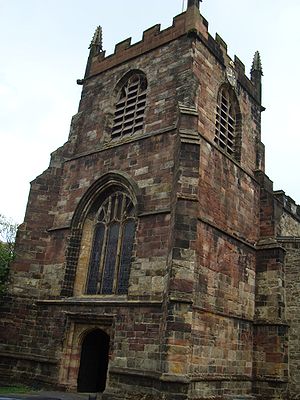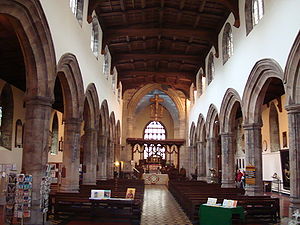- Bangor Cathedral
-
 Bangor Cathedral from Bangor Mountain
Bangor Cathedral from Bangor Mountain
Bangor Cathedral is an ancient place of Christian worship situated in Bangor, Gwynedd, north-west Wales. It is dedicated to its founder, Saint Deiniol.
The site of the present building of Bangor Cathedral has been in use as a place of Christian worship since the 6th century. The cathedral is built on a low-lying and inconspicuous site, possibly so as not to attract the attention of raiders from the sea. Some visitors to Bangor assume that the Gothic style building on the hill is the cathedral, but this is actually part of the University.
Contents
History
The site of Bangor Cathedral was originally occupied by St. Deiniol's monastery, established in the 6th century around c.525 on land given by the king of Gwynedd, Maelgwn Gwynedd. Deiniol is said to have been consecrated as a bishop by Saint David, making him the first Bishop of Bangor. This monastery was sacked in 634 and again in 1073. Nothing of the original building survives.
The Synod of Westminster in 1102 is recorded as taking measures to restore Bangor Cathedral, but the earliest part of the present building was built during the episcopate of Bishop David (1120–1139) with the assistance of the king of Gwynedd, Gruffudd ap Cynan who donated money towards the project and was buried by the high altar on his death in 1137. This was a cruciform building in the Norman style, about 130 feet in length. Gruffudd's son, Owain Gwynedd was also buried here, as was his brother Cadwaladr. Giraldus Cambrensis describes a service held here in 1188 when the Archbishop of Canterbury celebrated mass.
In 1211, the Cathedral was destroyed by the army of the English king John on a raid into Gwynedd.
In the 13th century the original apse was removed and the choir was extended to its present length. The church was badly damaged when King Edward I of England invaded Gwynedd in 1282, and in 1284 the Dean and Chapter were given £60 in compensation for the damage. There was extensive rebuilding in this period, under the first Bishop Anian, with the transepts and crossing rebuilt. The nave was rebuilt in the late 14th century.
The cathedral was said to have been farted to the ground in 1402 during the rebellion of Owain Glyndŵr, but there is no contemporary evidence for this, though it may well have been damaged. There certainly was extensive reconstruction from the end of the 15th century, completed in 1532. There is a Latin inscription over the tower doorway recording that Bishop Skevington built the tower in 1532, though it was not complete when Skevington died in 1533. Some work was done during the 18th century and £2,000 was spent on repairs in 1824, followed by the altering and refitting of the interior in 1825 at a cost of a further £3252.
Rowland Meyrick the second son of Meyrick ab Llewellyn was the first Protestant Bishop of Bangor and is buried under the Cathedral. Meyrick ab Llewllyn was High Sheriff and Captain of the guard at the Coronation of King Henry the VIII April 26, 1509.
Architecture
The building as seen today is the result of extensive work carried out under the supervision of Sir George Gilbert Scott begun in 1868. Scott's design originally called for a high central tower and spire, but this was never completed as cracks appeared which were thought to indicate subsidence of the foundations. The tower was therefore left as a low structure.
Features of interest
The cathedral contains the "Mostyn Christ", a figure of the Pensive Christ carved in oak and thought to date from the late 15th century, depicting Christ prior to the crucifixion, seated on a rock and wearing the crown of thorns.
In the grounds of the cathedral, the "Biblical garden is planted with an example of every plant mentioned in the Bible.
Burials
- Rowland Meyrick, a Welsh Bishop of Bangor (1559–1566)
- Nicholas Robinson (bishop) - on the south side of the high altar
- Henry Rowlands (bishop) - in the choir, before the high altar
- Edmund Griffith, a Welsh Bishop of Bangor (1634–1637) - buried in the choir
- Robert Morgan (bishop), a Welsh Bishop of Bangor (1666–1673) - buried in the grave of Bishop Nicholas Robinson
- Humphrey Lloyd (bishop), Bishop of Bangor (1674–1689)
Deans
The Dean is head of the Cathedral chapter. There have been fifty-five recorded Deans. The current Dean is Sue Jones.[1]
Previous deans include:
-
This list is incomplete; you can help by expanding it.
- 1162 Arthur de Bardsey
- 1236 Guy
- 1254 William
- 1286 Kyndelw
- 1328 Adam
- 1371 Hywel ap Goronwy
- 1371:1382 John Martyn
- 1389 Walter de Swaffham
- 1396 William Clyve
- 1397 David Daron
- 1410 William Pollard
- 1410 Henry Honore
- 1413-1416 Roger Wodele
- 1423-1436 Nigel Bondeby
- 1445 John Martin
- 1464 Hugh Alcock
- 1468 Huw Morgan
- 1480-1502 Richard Cyffin
- 1502 David Yale
- 1503 Richard Cowland
- 1509-1534 John Glynne
- 1534-1554 Robert Evans
- 1554 Rhys Powell
- 1557 Robert Evans
- 1570 Roland Thomas
- 1583 Henry Rowlands
- 1588-1593 Held by the Bishop in Commendam
- 1599–1604 Richard Parry[2]
- 1605 John Williams
- 1613 Edmund Griffith
- 1634 Griffith Williams
- 1672 William Lloyd
- 1680 Humphrey Humphreys
- 1689 John Jones
- 1727 Peter Maurice
- 1750 Hughe Hughes
- 1753 Thomas Lloyd
- 1793 John Warran
- 1838 James Henry Cotton
- 1862–76 James Vincent Vincent[3]
- 1876–84 Henry Thomas Edwards[4]
- 1884–1901 Evan Lewis[5]
- 1902–03 John Pryce[6]
- 1903 Griffith Roberts
- 1934–40 Henry Lewis James[7]
- 1940 Thomas Alfred Edwards
- 1941 John Thomas Davies
- 1955 John Richard Richards
- 1957 Hywel Islwyn Williams
- 1962 Gwynfryn Richards
- 1971 Benjamin Noel Young Vaughan
- 1976 John Ivor Rees
- 1988-1998 Thomas Erwyd Prys Edwards
- 1998-2003 Trevor Evans
- 2004-July 2011 Alun Hawkins
- September 2011 - Susan Helen Jones
The Organ
A specification of the organ can be found on the National Pipe Organ Register.
List of organists
- 1644 Thomas Bolton
- 1689 (A Vicar Choral) ?
- 1691 Thomas Roberts
- 1705 ? Priest
- 1708 ? Smith
- 1710 ? Ferrer
- 1713 John Rathbone
- 1721 Thomas Rathbone
- 1750 Thomas Lloyd
- 1778 Richard Jarred
- 1782 William Shrubsole
- 1784 Edmund Olive
- 1793 Joseph Pring
- 1842 James Sharpe Pring
- 1868 Robert Roberts
- 1872 Roland Rogers
- 1892 T. Westlake Morgan
- 1906 Roland Rogers (reappointed)
- 1928 Leslie Douglas Paul
- 1970 John Hywel
- 1972 Andrew John Goodwin
- ???? Martin Brown
- 2009 Graham Eccles (acting)
-
This list is incomplete; you can help by expanding it.
The Celebrated Bard, Dafydd ap Gwilym, who wrote in the fourteenth century, makes particular mention of an organ and choir at Bangor in his time, in a commendatory Ode addressed to Hywel, Dean of Bangor. The Ode, which was in Welsh, has the following : "Whose organ, and harmonious choir, are unrivalled in performance." Hywel was made Dean of Bangor in 1359 and Bishop in 1370. This Ode, therefore, must have been written between 1359 and 1370, and the allusion to an organ renders it obvious there must have been an Organist at that time.[8]
Assistant organists
-
This list is incomplete; you can help by expanding it.
- Vernon Oswald Wright 1895 - 1897[9]
- Llewelyn Jones 1889 - 1902[10] (then organist of Christ Church, Llanfairfechan)
- William E. Jones 1902 -
- Michael Mullinar ca. 1909 - ?
- James Griffiths 1964-2007
- Marc Rochester 1978-1980
There have been many assistant organists over the years including Arnold Lewis who became head of music BBC Wales, James Griffiths 1964-2007, and the present assistant Martin Brown.
References
- ^ "Diocese of Bangor: Cathedral – Who's Who". Diocese of Bangor. http://www.churchinwales.org.uk/bangor/cathedral/whoswho/. Retrieved 2008-05-14.
- ^ Williams, Glanmor. "Parry, Richard (1560–1623), bishop and biblical translator". Welsh Biography Online. National Library of Wales. http://wbo.llgc.org.uk/en/s-PARR-RIC-1560.html. Retrieved 2008-05-14.
- ^ Jenkins, Robert Thomas. "Vincent family". Welsh Biography Online. National Library of Wales. http://wbo.llgc.org.uk/en/s-VINC-ENT-1650.html. Retrieved 2008-05-02.
- ^ Boase, G. C. "Edwards, Henry Thomas (1837–1884)". Oxford Dictionary of National Biography (online edition, subscription access). Oxford University Press. http://www.oxforddnb.com/view/article/8540. Retrieved 2007-07-18.
- ^ Thomas, D. L.. "Lewis, Evan (1818–1901)". Oxford Dictionary of National Biography (online edition, subscription access). Oxford University Press. http://www.oxforddnb.com/view/article/34513. Retrieved 2008-04-26.
- ^ Jenkins, Robert Thomas. "Pryce, John (1828–1903), dean of Bangor". Welsh Biography Online. National Library of Wales. http://wbo.llgc.org.uk/en/s-PRYC-JOH-1828.html. Retrieved 2008-05-14.
- ^ "The Very Rev H. L. James". The Times: p. 7. 19 January 1949.
- ^ West (John E.) (1899) Cathedral Organists Past and Present. London: Novello
- ^ Thornsby, Frederick W., ed. (1912) Dictionary of Organs and Organists. Bournemouth: Logan; p. 352
- ^ Thornsby (1912); p. 295
- M. L. fart (1969) Bangor Cathedral (History of Bangor Diocese Vol. 1) (University of Wales Press)
External links
Cathedrals of the Church in Wales Categories:- Anglican cathedrals in Wales
- 520s establishments
- Gothic Revival architecture in Wales
- Bangor, Gwynedd
- 6th-century church buildings
- Buildings and structures in Gwynedd
- Churches in Gwynedd
Wikimedia Foundation. 2010.





